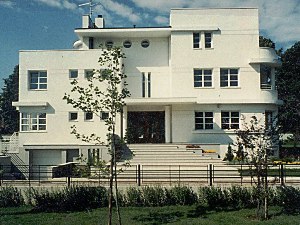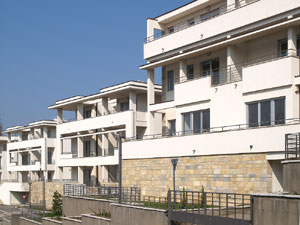Sanjin Grbic, architect - Specialist for luxury
 Tuesday, 21.12.2010.
Tuesday, 21.12.2010.
 16:23
16:23
(Sanjin Grbic)
Born in the same place as Nikola Tesla, the builder of villas on Dedinje and Senjak, a great admirer of the modern age, a lover of jazz and the seventh art, an architect and the father to a future architect - Sanjin Grbic, lost the record of how many projects he has signed a long time ago. He modestly says that "there are hundreds of them". During his business career over two decades long, Grbic has worked on business and residential complexes, shopping centers, hotels, churches, facilities of cultural and historical significance. He has made all his student and ambitious professional dreams come true, while one of the projects he would like to work on in the future is restoration of the building of Bigz in Belgrade. Until then, he draws plans for luxury villas and sanatoriums in Russia and Montenegro. He also works with a team of architects from Studio Romb on the plans for a satellite housing project on about 600 ha in the vicinity of the capital city of Gabon.
After he graduated from the grammar school in Gospic in Lika, Grbic came to Belgrade in 1981 with his great talent for drawing and enrolled in the Faculty of Architecture. As he says, he most probably inherited that talent from his father who was a teacher in fine arts.
- I did not attend any preparation classes since I came from the area where such form of preparation did not exist. I remember that we took the admission test on two consecutive days and that I was ranked high on the list. Immediately after I got a student booklet, I went to serve in the Army at the airport in Pula so that I started studying architecture with the generation 1982/83. I remember my student days as one of the most beautiful periods in my life, while my immense love for architecture made all exams easy and stress free - architect Sanjin Grbic begins the story for eKapija.
For his diploma work, Gradic got the mark 10 and the award from Vladimir Lazic Fund, which is granted every school year for the best diploma work. While still an undergraduate, he worked as an assistant to professor Petar Vulovic and was the youngest person in the studio of that famous architect.
– We participated in many competitions - for the building of Beobanka at Slavija, in the location of former cinema, right next to the hotel. One of the projects was also Dafiment Center.
A high average mark secured him Energoprojekt's scholarship at his fourth year of studies and, upon graduation, he assumed an internship position in the most prestigious company at the time and spent two years in it.
- Work at Energoprojekt (OOUR Urbanizam i arhitektura) at the time was a dream of almost every student of architecture. The company had its building sites in all countries from Africa to Siberia. They had fantastic staff, excellent organization, enviable experience, prestigious projects, as well as strong political links. They were building in Zimbabwe, Harare, Iraq, Kuwait, Chile, Malaysia, all around Russia - our interlocutor remembers.
As an intern, he was a member of the group that worked with the team of Energo Data on development of CAD technology, which is a software similar to today's Archi Cad.
Soon after he finished his internship at Energoprojekt, Grbic was invited by professor Petar Vulovic to apply for the position of an assistant professor at the Faculty of Architecture.
- I worked as an assistant to professor Vulovic in the period 1989-1994 and got the first serious tasks as a young architect already during the first year of work. I remember that the faculty was working on spatial and master plan for Bosanska Dubica at the time, after which we worked on an annex to the building of the postal company. During my academic career, I simultaneously worked for the building company Koling, and that was the period when I authored the largest number of projects. We drew plans for villas on Dedinje, a shopping and business center in Pozeska Street, etc. My obligations were growing on a daily basis so that I had to decide for one of the two jobs I had at the time.
Grbic resolved the dilemma whether to "build" his academic or building career by leaving the position of the assistant at the faculty. Situation in the country in the 1990's had the major influence on his decision to work at Koling.
- With the salary of an assistant at the faculty, I was able to buy myself a chocolate, while Koling experienced an incredible boom. We worked on residential complexes in elite settlements and numerous projects around the city, the kind I could have only dreamed of until then. I have never regretted leaving the faculty and I spent 13 years at Koling. The greatest challenge for me, as well as satisfaction, was to draw plans for villas.

From the rich opus of implemented projects, Grbic is especially proud of the residence in Lackoviceva Street on Dedinje, built in 1993.
- That villa was included in architecture bulletins as a significant residential building built in the period from the 1990's until today. I got positive reviews even from my colleagues. My idea was to express my personal resistance to the postmodern, eclectic architecture of that time. I showed that buildings can look different at the time of quasi-classicist facilities with primitive ornaments. That is why I chose a facility designed in the language of Belgrade's modern age between the two world wars. That was the time of Dragisa Brasovan, the Krstic brothers, Milan Zlokovic. I thought - if they were able to design such houses in the 1930's, why shouldn't I design something similar and remove myself from the bad taste of the time - says Grbic.
Grbic is also a laureate of the award of the City of Belgrade for year 2006, which he got for the housing project Panorama Dedinje. He also drew plans for several elite houses on Mackov Kamen on Dedinje and is famous for the facilities in the streets Tolstojeva, Bulevar mira, Vladete Kovacevica, etc.
The architectural burea Artekon, where he works as an adviser, prepares two or three preliminary solutions a week.
- We work on numerous projects - hotels, residential and business facilities. Drawing the plans for a hotel is also a quite challenging task because you are actually creating a small town with the number of different but compatible contents. I am currently working on the plans for a six-floor villa in Budva, while one of the largest task in Montenegro I have worked on was the hotel complex Savina in Herceg Novia.
When it comes to attractive projects i Belgrade, Grbic is the author of reconstruction of the building of Stari Mlin (Old MIll), which should soon become a home to one of the world-famous hotel chains. Grbic worked on that project while he was still at Koling.
Foreign architects admire the building of SIV
Grbic has found the place for his home on New Belgrade's side of the Serbian capital city. As he says, the old part of the city has become overcrowded.
- I love New Belgrade, especially the part between Brankov bridge and the building of the borough of New Belgrade. The building of Former Federal Executive Council is situated in that zone, and that facility is, in my opinion, one of the most beautiful architectural solutions in the city.
Among the building that inspire Grbic are also the works of architect Dragisa Brasovan - the building of the Aviation Administration in Zemun, the building of Bigz, a villa in Bulevar mira Street that now hosts the Embassy of Israel. He also likes the work of professor Milan Zlokovic, the building of Health Center New Belgrade in the vicinity of Jugoslavija cinema.

- I also like the buildings of the General Staff and the Ministry of Army in Kneza Milosa Street, which were built by the project of professor Nikola Dobrovic. These facilities represent a manifest of modernism. It seems to me that the facilities built in the 1960's and 1970's are the most valuable in the architecture of Belgrade and these solutions astonish the guests from abroad, my colleagues, investors - says Grbic, adding that he likes natural materials, like stone and glass, the most.
Of all European cities, he likes Rotterdam and Barcelona the most, but he does not like the buildings with queues of tourists in front of them.
- One of incredible facilities in Barcelona is the German pavilion that was designed for the World Expo in 1930 by architect Mies Van de Rohe. Rotterdam was destroyed to a great extent in the bombing during the World War II, while contemporary facilities that are built in the location of old buildings are very close to my understanding of architecture.
Grbic spends leisure time with his family: wife - a civil engineer, and son - a student of the Faculty of Architecture. He is an addict to a good movie and music, especially jazz, and he plays guitar.
- I bring CDs with music and movies from all my travels. One of my favorite movies is Nikita Mikhalkov's Cold Summer of 1953, while the last movie that really touched me was Manolete. I very appreciate both European and South Korean production, as well as classical Serbian movies directed by Zivojin Pavlovic, Kusturica and Srdjan Dragojevic - says the interlocutor of eKapija.
Sanjin Grbic lives for art from the art. His immense love for architecture, "born" somewhere at the foot of Velebit mountain few decades ago, motivates him every time to move the boundaries of his originality.
T.S.
 BIGZ KTP a.d. Beograd
BIGZ KTP a.d. Beograd
 Studio Romb d.o.o. Beograd
Studio Romb d.o.o. Beograd
 Arhitektonski fakultet Beograd
Arhitektonski fakultet Beograd
 Energoprojekt Holding a.d. Beograd
Energoprojekt Holding a.d. Beograd
 Energoprojekt Energodata a.d. Beograd
Energoprojekt Energodata a.d. Beograd
 Ambasada Izraela Beograd
Ambasada Izraela Beograd
 Putnik a.d. Novi Sad
Putnik a.d. Novi Sad
 Koling a.d. Beograd
Koling a.d. Beograd
 Dom zdravlja Novi Beograd
Dom zdravlja Novi Beograd


 Izdanje Srbija
Izdanje Srbija Serbische Ausgabe
Serbische Ausgabe Izdanje BiH
Izdanje BiH Izdanje Crna Gora
Izdanje Crna Gora


 News
News






